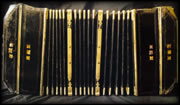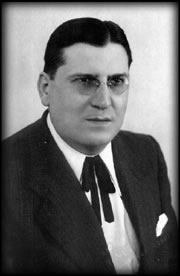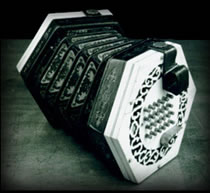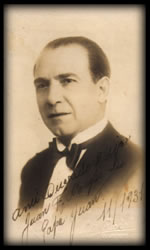By
The Bandoneon in the River Plate, Part II

f great are the controversies regarding its creation no less are those that surround its arrival in our country, when thinking about the questions: When? and Who did bring it?
It is thought that maybe it could have arrived after the first half of the nineteen century.
 The earliest mention of a bandoneon and its player in the River Plate is, up to now, a note published in a journal in 1995 by Jorge Labraña, and it came to the author without the name of the publication that issued it. In it its introduction is located in the year 1863 and it is attributed to a Swiss immigrant, natural of Sarganz named Schumacher who had traveled together with a group of countrymen with the intention of settling in the Swiss Colony of Uruguay, today called New Helvetia. His statement is based on the reading of a daybook of a Swiss military officer that voyaged with the group. He was the major Frederich Bion. The manuscript was found in 1970, in possession of a grandson of the above-mentioned military, in a city near Zurich. On December 19, 1862 he wrote in his notebook: «Schumacher, citizen of Sarganz, travels alone and will make his numerous family come later. His trade is blacksmithing, and he also wants to buy a farm, he's kind of grumbler, proud of being a citizen of Sarganz, he is our bandoneonist». But after his disembarking in Montevideo all tracks of the character are lost.
The earliest mention of a bandoneon and its player in the River Plate is, up to now, a note published in a journal in 1995 by Jorge Labraña, and it came to the author without the name of the publication that issued it. In it its introduction is located in the year 1863 and it is attributed to a Swiss immigrant, natural of Sarganz named Schumacher who had traveled together with a group of countrymen with the intention of settling in the Swiss Colony of Uruguay, today called New Helvetia. His statement is based on the reading of a daybook of a Swiss military officer that voyaged with the group. He was the major Frederich Bion. The manuscript was found in 1970, in possession of a grandson of the above-mentioned military, in a city near Zurich. On December 19, 1862 he wrote in his notebook: «Schumacher, citizen of Sarganz, travels alone and will make his numerous family come later. His trade is blacksmithing, and he also wants to buy a farm, he's kind of grumbler, proud of being a citizen of Sarganz, he is our bandoneonist». But after his disembarking in Montevideo all tracks of the character are lost.
 On September 23, 1919 the evening newspaper La Razón published an interview to an unknown bandoneon player that years later Héctor Bates and Luis Bates, in their book, identify as Antonio Chiappe, one of the pioneer performers. In the original text it is said: «This instrument was made known in our country around 1870 by Bartolo, the Brazilian who brought a 32-tone instrument, was one of the first bandoneonists». In the same book another possibility is sustained: that Don Tomás, (El Inglés) (The Englishman), brought it to the country around 1884.
On September 23, 1919 the evening newspaper La Razón published an interview to an unknown bandoneon player that years later Héctor Bates and Luis Bates, in their book, identify as Antonio Chiappe, one of the pioneer performers. In the original text it is said: «This instrument was made known in our country around 1870 by Bartolo, the Brazilian who brought a 32-tone instrument, was one of the first bandoneonists». In the same book another possibility is sustained: that Don Tomás, (El Inglés) (The Englishman), brought it to the country around 1884.
Before his departure to Europe in 1913, Vicente Loduca declared in a magazine: «The bandoneon came to our country at least thirty years ago.»
Antonio Bucich, historian and a passionate researcher of the past of the neighborhood of La Boca, affirms: «By the mid-1900, a German sailor began to sell musical instruments similar to the concertina in the neighborhood of La Boca. Those were the first bandoneons known in the country.»
Furthermore the leader and bandoneonist Augusto Berto, in a interview made in 1937 for the magazine Sintonía, said but without giving date: «As for the first bandoneon that is known, it is established its origin. Don Tomás El Inglés imported it. He was an extraordinarily nice character.» Was Thomas Moore one of the first bandoneon players known? And Berto continued: «Santa Cruz's father became a friend of his and from the concertina that he played the new instrument came out.»
 We can derive as conclusion of what was said that José Santa Cruz, as it has been written many times, was one of our first bandoneonists and that he already played it as a voice of bivouac in the war of the Triple Alliance that took place in the year 1865. If we take into account what Berto said, what Santa Cruz had played in this war would not have been a bandoneon but a concertina. The declaration of Berto also acknowledges the transformation of the concertina performers into bandoneonists, what agrees with what was said personally by Adolfo Pérez (Pocholo) to the author of this article. He affirmed that a great number of those mentioned as primitive bandoneonists played a smaller instrument and with a smaller number of notes. But in fact it was a concertina.
We can derive as conclusion of what was said that José Santa Cruz, as it has been written many times, was one of our first bandoneonists and that he already played it as a voice of bivouac in the war of the Triple Alliance that took place in the year 1865. If we take into account what Berto said, what Santa Cruz had played in this war would not have been a bandoneon but a concertina. The declaration of Berto also acknowledges the transformation of the concertina performers into bandoneonists, what agrees with what was said personally by Adolfo Pérez (Pocholo) to the author of this article. He affirmed that a great number of those mentioned as primitive bandoneonists played a smaller instrument and with a smaller number of notes. But in fact it was a concertina.
With regards to the introduction of the instrument other versions exist, most very arguable. Possibly there was not only one who introduced it but several ones and almost contemporarily.
Now we will refer to its inclusion in tango. When the bandoneon arrived those were times of trios, the habitual thing was flute, violin and guitar, previously they say that it was the harp, also the mandolin. The general trend was to play in unison, generally flute and violin, while the guitar was to keep the beat.
 The inclusion of the bandoneon found hard resistances in many tango men. Vicente Loduca, in 1913, said referring to this rejection: «Nobody wanted to learn it, they were very few those who dared to enter a saloon with it in its case. They were embarrassed of its aspect, of its vulgarity.» But it was gradually entering, by then it was written on the orchestras' slates on Avenida de Mayo. The first performers —the same thing happened with the first tango pianists— in the eve of their acceptance in the tango groups, they played as forced soloists alone.
The inclusion of the bandoneon found hard resistances in many tango men. Vicente Loduca, in 1913, said referring to this rejection: «Nobody wanted to learn it, they were very few those who dared to enter a saloon with it in its case. They were embarrassed of its aspect, of its vulgarity.» But it was gradually entering, by then it was written on the orchestras' slates on Avenida de Mayo. The first performers —the same thing happened with the first tango pianists— in the eve of their acceptance in the tango groups, they played as forced soloists alone.
There were, on the other hand, musicians of the Guardia Vieja (Old Trend) that, without being bandoneonists, they had an important role in the acceptance of the instrument by the rest of the tango men. Ernesto Ponzio in the 30s answered in an interview: «The acme of the bandoneon was due to Posadas, the famous violinist. He was the first one that taught to play the instrument. He began by studying how to play it.» Carlos Posadas, a musician of polished instruction, used to transcribe pieces to the bandoneonists adapting them carefully. Another one was El Pardo Sebastián Ramos Mejía, a musician that, by way of intuition, became a decisive figure in the process of its acceptance and diffusion. His contemporary, Antonio Chiappe, of solid musical knowledge, was the other supporting column in this transculturation phenomenon.
The inclusion of the bandoneon in tango took place a little before the Centennial (1910), when the primitive tango still reigned in 2/4, cheerful, jumping and fastly played, with notes in staccato. Since then bandoneon and tango have lived their bohemian life together.
The inclusion of the bandoneon in popular music groups coincided with a change of rhythm and articulation that imposed a slow and legato playing. The slur of notes and the continuous legato removed the jumping vivacity from tango, making it sluggish and slow. The jumping compadrito tango is an effect that is obtained playing staccato and the bandoneon players were very far from achieving such a way of playing due to their scarce command of the instrument.
As for the performers that played as soloists, a previous step before becoming members of an orchestra, logically among them Juan Maglio stands out. He cut the first a capella bandoneon solo recorded in the history of tango, when in 1912 he waxed the Pascual Cardaropoli's tango “La sonámbula” for Columbia. On the other side of the disc was Gerardo Metallo's mazurka “La morocha [b]” (homonym of Saborido's tango). Within the simplicity of conception of the time, Maglio stood out because of the sound and the expression that he achieved as well as for the correct legato and his way of showcasing the bass notes.
 Almost at the same time several of his colleagues followed the path opened up by Maglio. So in 1913 Genaro Espósito recorded for the ERA label his tangos “El goruta” and “Don Machado” and later others came for the Atlanta label. That same year, Vicente Loduca recorded for the French company Pathé his tango “El argentino” and the hardly known Arolas's tango “Piteco”. Loduca was the first Argentine bandoneonist that recorded as soloist abroad. By the same time the only rendition as soloist by Eduardo Arolas came true, for the Odeon company, his waltz “Aranzetti”. In this piece we can guess a quite flowing fingering —he had only studied for five years then— and an attractive bright sound in his right hand, with a less sharp sound than that of Loduca's.
Almost at the same time several of his colleagues followed the path opened up by Maglio. So in 1913 Genaro Espósito recorded for the ERA label his tangos “El goruta” and “Don Machado” and later others came for the Atlanta label. That same year, Vicente Loduca recorded for the French company Pathé his tango “El argentino” and the hardly known Arolas's tango “Piteco”. Loduca was the first Argentine bandoneonist that recorded as soloist abroad. By the same time the only rendition as soloist by Eduardo Arolas came true, for the Odeon company, his waltz “Aranzetti”. In this piece we can guess a quite flowing fingering —he had only studied for five years then— and an attractive bright sound in his right hand, with a less sharp sound than that of Loduca's.
Finally, we have to say that it was usual to adjust its tuning to 440, that it corresponds to the number of vibrations of the note A of the pitch, but nowadays it's usual to raise it to 441 and even still to 442. But this already belongs to the land of tuners.
Excerpted from the book El tango, el bandoneón y sus intérpretes, by Oscar Zucchi. Editorial Corregidor, 1998, Volume l.